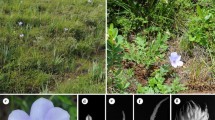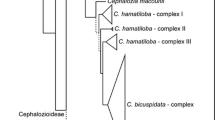Abstract.
The tribal affinities of Cratystylis and Haegiela were assessed using three chloroplast DNA sequences, the trnL/F spacer, the trnL intron and the matK coding region. The outgroup was represented by two species of the subfamily Barnadesioideae, whereas one to seven genera (45 species including Cratystylis and Haegiela) of the tribes of the Asteroideae [Anthemideae (6 genera), Astereae (7), Calenduleae (2), Gnaphalieae (7), Heliantheae s.l. (5), Inuleae s.str. (3), Plucheeae (3), Senecioneae (4)] and Cichorioideae, [Arctotideae (1), Cardueae (2), Lactuceae (2), Liabeae (1), Mutisieae (1) and Vernonieae (1)] comprise the ingroup. Phylogenetic analysis indicates that Cratystylis has strong support as a member of the tribe Plucheeae, whereas Haegiela is a member of Gnaphalieae. At some point in their taxonomic history, both genera have been placed in these tribes and there are good morphological and chemical characters that justify these placements. The monotypic Haegiela was once included in Epaltes (Plucheeae) and this study has confirmed the need for the separation of the two genera. The genus Cratystylis appears to be monophyletic.
Similar content being viewed by others
Author information
Authors and Affiliations
Additional information
Received August 26, 2002; accepted September 19, 2002 Published online: February 7, 2003
Rights and permissions
About this article
Cite this article
Bayer, R., Cross, E. A reassessment of tribal affinities of Cratystylis and Haegiela (Asteraceae) based on three chloroplast DNA sequences. Plant Syst. Evol. 236, 207–220 (2003). https://doi.org/10.1007/s00606-002-0233-x
Issue Date:
DOI: https://doi.org/10.1007/s00606-002-0233-x




